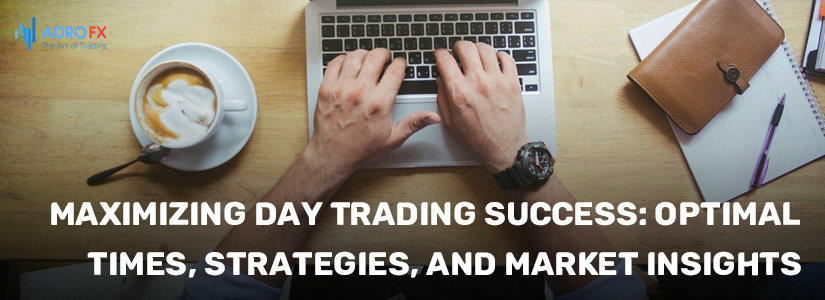Maximizing Day Trading Success: Optimal Times, Strategies, and Market Insights

When it comes to day trading, simplicity can be beneficial. Spending two to three hours daily is often more advantageous for most traders in stocks, stock index futures, and index-based exchange-traded funds (ETFs) compared to engaging in constant buying and selling throughout the day.
By focusing on specific hours, you can optimize your day trading opportunities and enhance your effectiveness. Engaging in trading activities all day consumes excessive time without providing substantial additional rewards. Even experienced day traders often experience financial losses when operating outside these optimal trading hours.
Optimal Trading Times for Day Trading the Stock Market
The prime windows for day trading in the stock market are typically the initial two hours after the market opens and the final hour before it closes. In the United States, this timeframe spans from 9:30 a.m. to 11:30 a.m. EST as the market commences, and from 3:00 p.m. to 4:00 p.m. EST during the closing hours. It is crucial to comprehend the specific trading hours of the stock market you intend to engage in, ensuring that you trade during the most favorable periods.
Trading at Market Open For many traders, participating in the stock market during the first one to two hours after it opens is sufficient. The initial hour is typically characterized by heightened volatility, offering ample opportunities (along with potential risks). Seasoned traders often recognize that this is when a significant influx of uninformed or "dumb money" flows into the market.
"Dumb money" refers to individuals who base their transactions on outdated news they read or saw on television the previous night. Acting upon stale information, their trades can trigger sharp price movements in one direction. Professional traders then take advantage of these inflated or deflated prices, driving them back to their original levels.
While it may sound harsh, new day traders are often advised to refrain from trading during the first 15 minutes of the day. However, experienced traders understand that this brief period presents some of the finest opportunities. During this time, significant trades can occur based on initial trends, leading to potentially substantial gains.
Optimal Trading Times During the Day
The hour from 9:30 a.m. to 10:30 a.m. EST, which corresponds to the start of regular trading, is often considered the best trading time of the day. It tends to provide the most significant price movements within a condensed timeframe, offering potential opportunities for traders.
Around 11:30 a.m., many professional day traders tend to conclude their trading activities as volatility and trading volume begin to diminish. During this period, trades take longer to materialize, and price movements become smaller due to lower trading volume. This combination is less favorable for day trading strategies.
If you are day trading index futures, such as the E-mini S&P 500 (ES), or index-based ETFs like the SPDR S&P 500 (SPY), you may consider extending your trading hours. Futures trade nearly 24 hours a day during weekdays, allowing for early morning trading starting from 8 a.m. during pre-market hours. However, it is advisable to taper off around 10:30 a.m., as this two-hour window usually holds substantial profit potential.
Note that trading can continue past 11:30 a.m. EST for both stocks and futures, provided that the market still presents opportunities aligning with your trading strategies.
Trading during the Last Hour
Many day traders also engage in trading during the final hour of the day, from 3 p.m. to 4 p.m. EST. This time period allows traders to regroup and refocus after the break since the morning session.
The last hour often exhibits characteristics similar to the first hour, featuring significant price movements and sharp reversals. Similar to the morning, some novice traders enter the market during this hour, making trading decisions based on the day's earlier developments. Once again, there is the presence of "dumb money," although not as prominent as in the morning. Experienced money managers and day traders are ready to capitalize on these opportunities.
Note that the last few minutes of trading can be particularly active, with substantial moves occurring on high trading volume.
Optimal Days and Months for Stock Market Trading
While focusing on the daily grind is important, it is equally crucial to consider the broader perspective when it comes to trading in the stock market. Historically, Monday afternoons have been favorable for buying, as the market tends to experience a drop at the beginning of the week, especially around the middle of the month. Experts often recommend selling on Fridays before the anticipated Monday dip, particularly if that Friday marks the start of a new month or precedes a three-day weekend.
Moreover, prices tend to decline in September and then rise again a month later. October generally demonstrates positive performance overall, and prices often experience an upswing in January, particularly for value and small-cap stocks.
The key takeaway is that day trading demands discipline and focus, both of which can be compared to muscles. Overworking them can result in exhaustion. By limiting your trading hours to two to three hours a day, you can maintain your focus and avoid mental fatigue that might adversely impact your performance. Attempting to trade for six or seven hours daily can drain your energy and increase the likelihood of making mistakes.
Of course, individual levels of focus and discipline may vary. While some traders may excel at buying and selling throughout the entire day, most find greater success by trading only during the optimal hours for day trading.
It's important to note that day trading is not suitable for everyone, and it carries various rules and risks. Before trading with real money, ensure you understand the intricacies of day trading and practice to determine if it aligns with your trading style and goals.

About AdroFx
Established in 2018, AdroFx is known for its high technology and its ability to deliver high-quality brokerage services in more than 200 countries around the world. AdroFx makes every effort to keep its customers satisfied and to meet all the trading needs of any trader. With the five types of trading accounts, we have all it takes to fit any traders` needs and styles. The company provides access to 115+ trading instruments, including currencies, metals, stocks, and cryptocurrencies, which make it possible to make the most out of trading on the financial markets. Considering all the above, AdroFx is the perfect variant for anyone who doesn't settle for less than the best.








